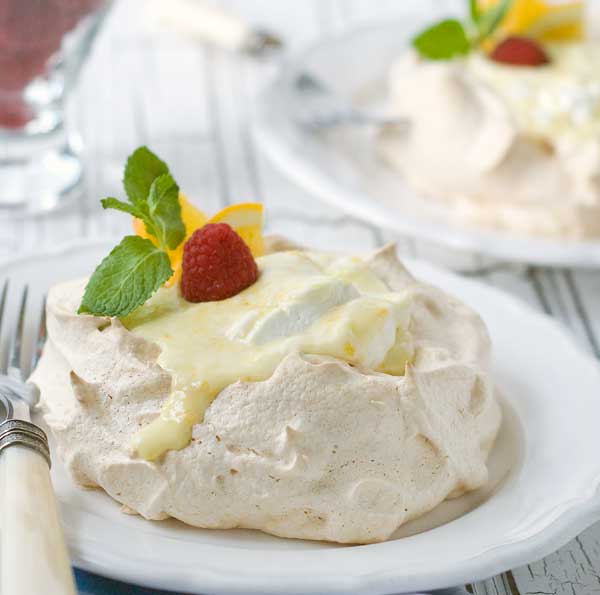Gluten Free Creamsicle Pavlovas Recipe
Updated May 29, 2020, Published Aug 08, 2012
This post contains affiliate links. Please see our disclosure policy.
To be an amazing, paparazzi-hounded, supersonic, gluten free dessert-making rock star, you don’t need thousands of recipes. All you need are a handful of basic recipes and techniques you have mastered.
Nor do you need to go buy unusual, expensive, and hard to find ingredients. At least not if you master a few naturally gluten free recipes.
This recipe includes not one but two of what I consider basic recipes well worth learning – meringue and citrus curd.
Meringue
Meringue can be used to top a pie, create a naturally gluten free crust for tarts, made into cookies, layers for tortes and as is the case in this recipe, Pavlova. It is basically just egg whites and sugar; nothing expensive, nothing hard to find and nothing fancy – except the results. There are soft meringues and hard meringues; the difference is basically the amount of sugar added – less for a soft meringue (for topping pies and Baked Alaska) and more for a hard meringue (tarts shells, cookies, etc.)
There are a few tricks to making perfect meringue. First is to use room temperature egg whites. One of those ironic twists of fate is that cold eggs are easier to separate and room temp egg whites easier to whip so I separate my whites, gather up the rest of the ingredients and maybe make a cup of coffee, all of which gives my eggs a chance to get the chill off; half an hour is perfect. It is also important that not one speck of egg yolk be present in the whites, so separate them carefully.
Make sure the bowl and beaters of your mixer are completely clean without any grease. Grease and fat impede the whipping of eggs (which is why you don’t want even a tiny bit of yolk in your whites).
DO NOT ADD SUGAR BEFORE WHIPPING THE EGGS! This will increase the whipping time by as much as double and you will risk overbeating your eggs. Beat the eggs until they form soft peaks and then GRADUALLY add in your sugar, a tablespoon at a time; this will give you a smoother (not grainy) result and will make your meringues more stable.
Superfine sugar incorporates into the egg whites faster, making it smoother. If you don’t have superfine sugar, just take your regular sugar and process it in a food processor for about 30 seconds. If you don’t have superfine sugar or a food processor, it’s okay, just add the sugar really slowly and test for graininess by rubbing some of the mixture between your thumb and index finger, if it feels gritty, it means the sugar has not been fully dissolved and you need to keep beating.
Humidity is the foe of meringue, so it is best not to make meringues on a rainy or excessively humid day. Baking meringue in a low oven helps to dry out the whites.
Pavlova is basically a meringue with a couple of differences – the addition of cornstarch and acid of some type; cornstarch gives the Pavlova a crisp and crunchy outer shell, and a soft, moist marshmallow-like center, unlike meringue, which is usually solid throughout. The acid can be lemon juice or vinegar.
Citrus Curd
Citrus curd is nothing more than eggs yolks, citrus juice and zest, sugar and butter (dairy free is fine too). You can use any kind of citrus you like – lemon, lime, grapefruit or in this case, orange. Again, a little elbow grease (this time provided by you) and heat and you have a versatile topping or filling for pies, tarts, cookies, scones, toast or, as I often do, to be eaten right off the spoon.
The main thing to know about making citrus curd is that you are cooking the egg yolks and you want a lovely, silky product, not a pan of scrambled eggs. Slow cooking is the answer; I cook mine in a mixing bowl set over a pan with an inch of simmering water. This keeps the temperature low and constant.
Whisking the egg yolks with the sugar first, before placing it over heat, will help you prevent the scrambled egg problem as well. Beat the yolks and sugar together for 2 minutes, add the citrus juice and zest and beat that in and then place the mixing bowl over the simmering water. Your mixture will look a little curdled but not to worry, it will smooth out as it starts to heat up. Constant stirring while the curd cooks is essential – it takes about 6 minutes of patience but the results are so worth it!
If you are really challenged in the stirring department, leave out the zest, make the curd and then strain it through a fine sieve. This will take out any bits that aren’t as smooth as you like. Then stir in the zest.
Cold butter, whisked in slowly once the curd has thickened, makes for a silky, gorgeous curd. Cut your butter into small pieces and whisk in each piece until fully incorporated before adding the next.
Combining two recipes that make use of both the white and yolk of the egg just makes really good sense and will quite honestly wow your friends and family with your mad culinary skills!
While these recipes don’t require any special ingredients, it is good to use the best ingredients; the recipes are so simple that the ingredients shine. Since the zest of the citrus is used, buy organic and for a richer curd and fluffier meringues, use organic, cage free eggs (I use Nature’s Yoke).
I used these two basic recipes, added my own twist and came up with a dessert inspired by my favorite ice cream truck treat – the Creamsicle. Master this, or switch up the flavors as you like and be prepared to start dodging those darn paparazzi!

Gluten Free Creamsicle Pavlovas Recipe
Ingredients
- 4 large organic free range eggs
- 1/8 teaspoon salt
- 1 cup superfine sugar
- ½ tablespoon cornstarch
- 1 teaspoon fresh lemon juice
- 1 teaspoon pure vanilla extract
- 2/3 cup sugar
- ¼ cup fresh orange juice, from 1 or two oranges
- 2 tablespoons orange zest, form 1 orange finely grated
- 6 tablespoons cold butter, cut into small pieces
- 1 cup heavy cream
Instructions
- Preheat the oven to 300 degrees. Line 2 baking sheets with parchment paper. You can trace 4 4-inch circles (a ramekin works well) onto each piece of parchment to get more perfect circles if desired. Place the traced side down on the baking sheet.
- Separate the egg whites from the yolks, placing the whites in the bowl of an electric mixer fitted with a whisk attachment and reserve the yolks for later. Add the salt to the egg whites and beat, starting on low, and then increasing the speed to high, until soft peaks form. Add the 1 cup superfine sugar to the eggs with the mixer going, one tablespoon at a time. Whip until stiff, glossy peaks form. Add the cornstarch, lemon juice and vanilla and beat in.
- Place 8 equal dollops of the egg white mixture onto the prepared baking sheets. With the back of a spoon, spread the egg whites into circles and create a well in the center of each. Make sure the edges of the meringues are higher than the center. Bake for 1 hour or until crispy and dry. Let cool on a wire rack.
- While the meringues are baking, prepare the orange curd.
- Place an inch of water in a pan that is wide enough to hold a mixing bowl on it without the bottom of the bowl touching the water and bring to a simmer.
- In the mixing bowl, beat the egg yolks and 2/3 cup sugar for 2 minutes on medium speed. Beat in the orange juice and zest. It will look curdled; this is okay. Place the mixing bowl over the simmering water and stir constantly with a spatula, making sure to scrape the sides and bottom of the bowl as you stir. Cook until thickened enough to coat the back of a spoon, about 6 or 7 minutes. Whisk in the pieces of butter one at a time, making sure to whisk until each piece of butter is incorporated before adding the next. Pour the orange curd into a bowl, let cool and refrigerate until cold.
- Just before serving, whip the cream until stiff peaks form. Whisk half of the cream into the orange curd until smooth. Gently fold in the remaining whipped cream, leaving the mixture streaky. Spoon the filling into the meringues and serve.
Notes
Nutrition
Nutrition information is automatically calculated, so should only be used as an approximation.
The views and opinions expressed on this blog are purely the blog owner’s. This blog accepts free manufacturers’ samples and forms of cash advertising, sponsorship, paid insertions or other forms of compensation. Affiliate links may be included in this post.















Here in Australia, pavlovas are a sacred part of our summer! They are one of my ultimate favourite desserts in the universe :) This one looks very lovely indeed, and the citrus curd would be a perfect match- yummo!
I love them too and since they are naturally gluten free, I like to play around with different flavors. There really is something magical about egg whites and sugar transforming into pure bliss!
Holy Amazingness! This looks fab and I love your tips!
Wow that is big praise – thank you!
WOW! Oh, these, look *so* good! And pretty to serve to guests, too!
Thanks Jen!
These look like little pieces of heaven!
Thats a perfect way to say it! Thank you.
I love pavlova! There are so many variations and it’s a recipe that I’ve been able to enjoy in upscale “real food” restaurants because it’s naturally gluten free as you’ve stated. A creamsicle version is fantastic–gorgeous job! :-)
Shirley
Thank you Shirley!